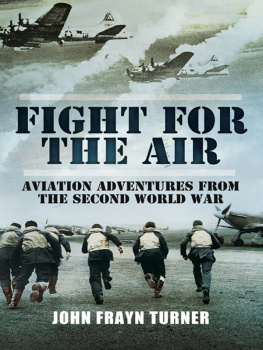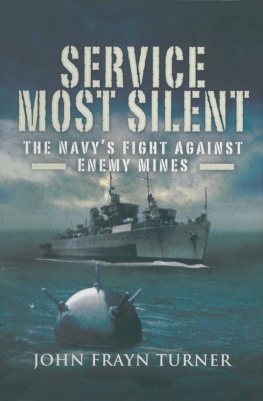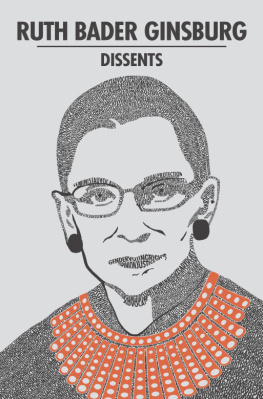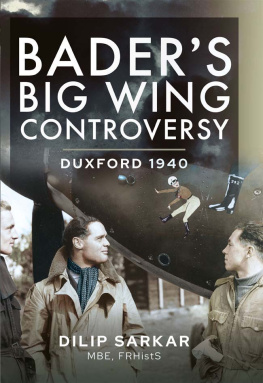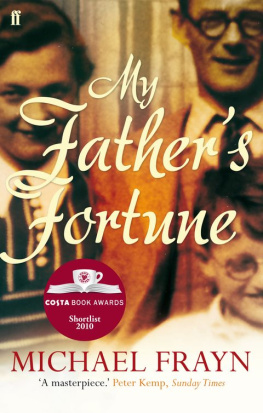THE
BADER
WING
By the same author
Service Most Silent
VCs of the Royal Navy
Prisoner at Large
Hovering Angels
Periscope Patrol
Invasion 44
VCs of the Air
Battle Stations
Highly Explosive
The Blinding Flash
VCs of the Army
A Girl Called Johnnie
Famous Air Battles
Destination Berchtesgaden
British Aircraft of World War 2
Famous Flights
VCs of the Second World War*
For Gallantry Awards of the George Cross 1940 2005*
The Life and Selected Works of Rupert Brooke*
Heroic Flights*
The Good Spy Guide
The Yanks are Coming
Fight for the Sea
Fight for the Air
The Bader Tapes
The Battle of Britain
Frank Sinatra
special research credited in
Fight for the Sky by Douglas Bader*
* In print with Pen & Sword Books Ltd
THE
BADER
WING
JOHN FRAYN TURNER
First published in Great Britain in 1981 by Midas Books
Reprinted in 1990 by Airlife Publishing Ltd
Published in this format in 2007 by
Pen & Sword Aviation
An imprint of
Pen Sword Books Ltd
47 Church Street
Barnsley
South Yorkshire
S70 2AS
Copyright John Frayn Turner 1981, 1990, 2007
ISBN 978 1 84415 544 6
The right of John Frayn Turner to be identified as Author of this work
has been asserted by him in accordance with the Copyright, Designs and Patents Act 1988.
A CIP catalogue record for this book is
available from the British Library
All rights reserved. No part of this book may be reproduced or transmitted
in any form or by any means, electronic or mechanical including
photocopying, recording or by any information storage and retrieval
system, without permission from the Publisher in writing.
Printed and bound in England
By CPI UK
Pen & Sword Books Ltd incorporates the Imprints of Pen & Sword
Aviation, Pen & Sword Maritime, Pen & Sword Military,
Wharncliffe Local History, Pen & Sword Select, Pen & Sword Military
Classics and Leo Cooper.
For a complete list of Pen & Sword titles please contact
PEN & SWORD BOOKS LIMITED
47 Church Street, Barnsley, South Yorkshire, S70 2AS, England
E-mail: enquiries@pen-and-sword.co.uk
Website: www.pen-and-sword.co.uk
This is the first book to deal exclusively with 12 Group and its crucial contribution to the Battle of Britain. These squadrons were based entirely north of the Thames and led by the legendary Douglas Bader. Other accounts have included their part in the overall fight, while some have been less than fair to 12 Group in the Big Wing controversy that has surrounded its activities for 66 years.
To tell this inspiring story, I have had access to every original log of every single sortie by every pilot in 12 Group. As well as studying these thousand or so reports, I have also, of course, seen the broader records of both 11 and 12 Groups and Fighter Command itself. In this way I have tried to piece together a comprehensive version of the Big Wing in its relation to the Battle of Britain. I feel that the facts presented by assembling this aerial jigsaw speak for themselves and more eloquently than any theories. The Big Wing worked.
Douglas Bader was the legless leader of this unique five-squadron wing. I knew him for a number of years and felt fortunate to count him as a friend. I am well aware that he would have wanted to distance himself from any sort of subjective controversy about the Big Wing, and he would also have insisted on giving fullest honour to the many pilots who flew with him in 1940 and 1941. However, I hope that my view of the events portrayed in this book accord more or less with his own feelings about those unrepeatable days. Douglas actually read this book before he died.
I am grateful to the distinguished pilots whose exclusive comments on Bader are quoted here: Johnnie Johnson, Peter Townsend, Laddie Lucas, Sholto Douglas, Peter Brothers, Hugh Dundas and Alan Deere. I would also like to thank William Collins for permission to reprint the brief but telling extract by Paul Brickhill from Reach from the Sky. Apart from that, I must accept responsibility for the rest of the text. I should also just add that I naturally referred to The Bader Wing in two of my later books, The Battle of Britain and Douglas Bader.
John Frayn Turner
2007
On 14th December 1931, Douglas Bader was about to face the need to come to grips with life for the first time. He was twenty-one years old and flying Bulldogs as a Royal Air Force pilot officer in 23 Squadron at Kenley, Surrey. Douglas flew over to Woodley Aerodrome, Reading, with a couple of other pilots, Phillips and Richardson, in their three Bulldogs to see Phillips brother there. They had coffee and chatted to some of the chaps in the flying club at Woodley. One or two of them had been trying to needle Douglas into showing them some aerobatics, but the RAF pilots were under orders not to do so. Douglas had taken part in the Hendon Air Display as part of the Gamecocks aerobatic team.
The trio took off in their Bulldogs to fly back to Kenley. Phillips and Richardson went first, while Douglas brought up the rear. He was still thinking of this needling in the clubhouse and decided to show them what he could do. He turned, dived low over Woodley field and did a slow roll a few feet off the ground. He made a slight mistake with his Bulldog, which crashed on to the grass somewhere in the middle of the airfield. Douglas finished up with the whole aeroplane wrapped around him.
He was not dead. He was not even unconscious. But he had hurt himself very badly. His right leg had the rudder bar right through the knee and was very nearly severed from his body. His left leg was broken between the knee and the ankle where the seat had been faced forward and he was still sort of sitting on it. The strange thing was that he did not seem to be feeling any particular pain in this messy lower part of his crushed body. Douglas was of course wearing his usual flying overalls and uniform, so the evidence of the crash was not yet apparent, but all tangled up in his clothing. The pain that he did in fact feel came from his back. The fighting harness had held him back when the aeroplane hit the ground and his body had tried to lurch forward. This harness saved his life and he felt the pain from the wrench to prove it. At that first minute after impact, Douglas simply sensed a kind of buzzing in both his legs, rather like the feeling you get when hitting your funny-bone. Only this was in his legs.
Douglas and the aeroplane finally landed upright and did not catch fire. A man called Cruttenden got to the Bulldog first, undid the straps, somehow dragged Douglas out of the cockpit, and transferred him to an ambulance that had arrived with commendable speed. Cruttenden sat with him in the ambulance and saw that he was bleeding dangerously from his right leg. Douglas had severed the artery and so Cruttenden stuck a large hand tightly over the bit of overall and leg where it was all emerging. Douglas is convinced that Cruttenden saved his life by that action alone.
They hurried him to the Royal Berkshire Hospital at Reading, where the next thing he remembered was lying on or near the operating table, with the face of the splendid anaesthetist, Commander Parry Price, gazing down at him. Price was about to put the nozzle over Douglass face, when he protested as vehemently as he could:



